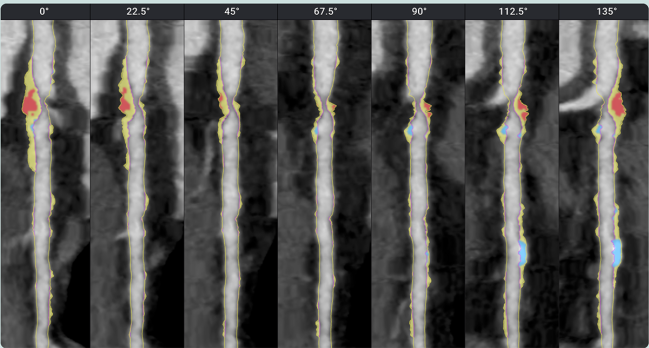AI-QCT Possibly Lessens Gap Between Ideal vs Actual Care for Patients at Risk of ASCVD
The “hypothesis-generating” results show that the technology might improve use of preventive therapies, especially in women.

Photo Credit: Cleerly
MONTREAL, Canada—Artificial intelligence-based quantitative computed tomography (AI-QCT) can potentially improve preventive care for patients, especially women, thought to be at risk for atherosclerotic cardiovascular disease (ASCVD), according to an analysis of the CERTAIN study.
In the analysis, presented as a poster Saturday at the 2025 Society of Cardiovascular Computed Tomography (SCCT) meeting, the software (Cleerly) recommended new medications for almost two-thirds of patients who had previously undergone cardiac computed tomography angiography (CCTA), yet only about half of those had actually initiated therapy by 90 days in the real world. The disconnect between treatment recommendations and actual prescriptions was greater for female compared with male patients.
“If we maybe would be able to prescribe more towards the AI-QCT results, then we could maybe close this gap a bit more,” lead author Sophie Cramer, MD (Vrije Universiteit Amsterdam, the Netherlands), told TCTMD, adding that the technology is not subject to bias like some physicians might be. The results are currently “hypothesis-generating,” she added.
More Statins, Aspirin Prescribed
Cramer and colleagues analyzed 700 symptomatic patients (mean age 63.5 years; 56.3% male) who had undergone clinically-indicated CCTA at one of five US centers as part of the CERTAIN study and received an initial medication plan based on the results. Baseline medications included statins (56.7%), aspirin (38.7%), and beta-blockers (26.3%).
Patients were stratified into plaque stages based on total plaque volume as seen on AI-QCT: 0 (1.0%), 1 (> 0-250 mm3; 61%), 2 (> 250-750 mm3; 28%), and 3 (> 750 mm3; 10%). When physicians were unblinded to the AI-QCT, they recommended new medications for 61.6% of patients.
At 90 days, the researchers found that only 29.7% of patients had initiated a new medication (P < 0.001). Statins and aspirin were recommended to 30.1% and 35% of patients, respectively, but only 7.7% and 4.7% filled a prescription by 90 days (P < 0.001 for both). The findings were consistent across all plaque stages (P < 0.01 for all).
Results from the AI-QCT led to similar rates of new medication recommendations in females and male patients (59.8% vs 60.9%), although women were less likely than men to receive a new prescription within 90 days (25.8% vs 32.7%; P < 0.001). In total, women received the recommended preventive therapy less often than men at follow-up (43.2% vs 53.8%; P = 0.031).
“The real-world gaps may be even larger as fulfillment and adherence of the prescribed medications were not assessed,” Cramer said, adding that it would also be interesting to see what happens when the AI-QCT results are shared with patients (they were not in this study). “Making patients and physicians more aware of the real disease can improve adherence.”
The burgeoning field of AI plaque analysis based on CCTA is making waves: another recent study presented at SCCT also showed the impact that this technology can have on clinical management and last year the CONFIRM2 study demonstrated the ability of AI-QCT to quantify components of CAD. The concept of plaque staging is nascent and vendor-specific, which makes comparison between the available software types difficult.
“If you check one patient with all these different vendors, you will get different results in a way,” Cramer said. “So I think there’s a lot of things coming.” The ongoing TRANSFORM study, with results due in 2028, will hopefully help clarify how these AI tools can help improve outcomes, she added.
Yael L. Maxwell is Senior Medical Journalist for TCTMD and Section Editor of TCTMD's Fellows Forum. She served as the inaugural…
Read Full BioSources
Cramer S. Impact of atherosclerosis imaging-quantitative computed tomography on medical treatment recommendations vs. real-world prescriptions. Presented at: SCCT 2025. July 19, 2025. Montreal, Canada.
Disclosures
- Cramer reports no relevant conflicts of interest.





Comments